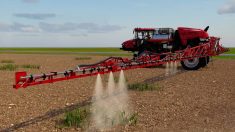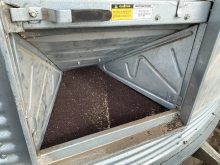We’ve all done it. Pushed our crop rotations, that is. You know that field had canola on it two years ago, but the seed you have already purchased, the fertilizer you applied last fall, or the delivery contract you already signed all make us do things that we know are not in our best agronomic interests.
In our case it was a shift in the acres to maintain our normal four-year rotation. I didn’t like it, but we needed to sow Roundup Ready canola on the same field two years in a row.
Read Also

Farm equipment sales sector sees significant structural changes
Farming equipment sales have been declining for a number of years now, and one industry professional believes structural changes in the industry are needed to curb that trend.
The field in question had a history of broadleaf weeds, most notably lady’s thumb, so I managed to console myself with the knowledge that at least I had an opportunity to clean up some weeds. And it did. At least it had a significant impact on the lady’s thumb populations. What I did notice however, was that I was left with regrowth of redroot pigweed that the glyphosate was apparently weak on.
For a product improperly used to belie its weaknesses should come as no surprise. Glyphosate has been used for years as the silver bullet to clean up weeds when nothing else would. Quack grass, Group 1-resistant wild oats, and wild mustard in GMO canola have all fallen victim to its broad-based ability to clean up fields in a single swoop, but it would seem the silver has started to tarnish.
Glyphosate-resistant kochia was recently detected in Alberta. A first for Western Canada, but it joins giant ragweed that was detected in Ontario in 2009 and the Canada fleabane that was detected in 2011. These followed discoveries in the U.S. of glyphosate-resistant palmer amaranth (known there as pigweed), mare’s tail in South America, ryegrass in Australia and Johnson grass in Argentina.
The threat of resistant weeds however, pales in comparison to the charges being made by a retired professor from Purdue University. Dr. Don M. Hubner has reportedly sent warnings to USDA Secretary Tom Vilsack citing production problems with increased diseases in GMO crops and reproduction issues in animals being fed GMO grains.
While Dr. Hubner has over 40 years of research experience, his findings have not been wholeheartedly embraced by the scientific community. Purdue University has tried to distance itself from the controversy, and has released a statement saying that the studies have been taken out of context. Others argue that Dr. Hubner’s claims are not the result of peer-reviewed science and that what he is doing borders on sensationalism.
It is also unfair to extrapolate the animal studies to humans. While a cow or a pig being fed on a farm that grows GMO feed grains may see over 80 per cent of its diet derived from those products, very few Canadians would consume over 20 per cent of their diet from corn, soybeans or canola. The level of exposure is dramatically different.
Canola/snow rotations
So what does it all mean for the farmer deciding what to grow next spring? No. 1, it means more studies will have to be conducted before we know the full extent of whether Dr. Hubner’s allegations are true. No. 2, it means we need to start paying closer attention to those crop rotations that have been getting notoriously compressed into a canola/wheat ( or in some cases, canola/snow) rotation. With different crops we need to alternate different herbicides and production practices to halt the onslaught of resistant weeds.
If you thought the answer to Group 1- and Group 2-resistant grassy weeds was glyphosate-tolerant wheat, think again. We already have the option of Roundup Ready canola, soybeans and corn, the acreages of which could increase if our climate were to warm as predicted. In addition, glyphosate is also being used as a pre-seeding burn-off, pre-harvest thistle control and post-harvest weed control. The tolerance to this product by weed species is already sounding off alarms, and it’s time to heed the warning.
Additionally, if there is any linkage between humans and the animal studies that Dr. Hubner is citing, adding a GMO wheat to our own diet may not be a good plan either. We consume a lot more wheat products than corn, soybeans or canola.
In the final analysis, there really are no silver bullets. GMOs will continue to have a role in our farming plans as part of a rotation, but they cannot be the be-all and end-all for the modern farmer to feed a hungry world. What will prevail over the long haul will be sound agronomic practices, innovation, and wise old farmers.














